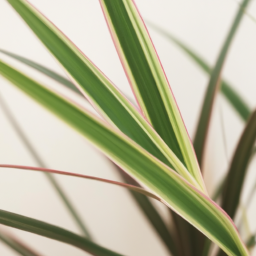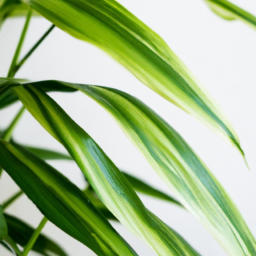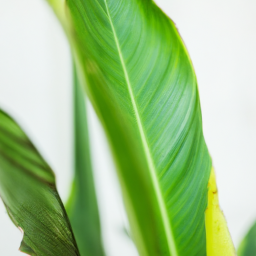
Looking to add some greenery to your indoor space? Consider an indoor plant with long leaves! Not only do these plants bring a touch of nature indoors, but their elongated leaves can also add height and drama to your decor. Whether you’re a seasoned plant parent or just starting out, there are plenty of options to choose from when it comes to indoor plants with long leaves. In this blog post, we’ll explore some of the best options for adding a touch of green to your home or office.
Snake Plant: A Popular Indoor Plant with Long Leaves
Introduction
When it comes to indoor plants with long leaves, one of the most popular choices is the snake plant. Also known as Sansevieria, this plant is loved for its striking appearance and low maintenance requirements. In this guide, we will explore the characteristics of the snake plant, how to care for it, and some creative ways to incorporate it into your indoor space.
Characteristics of the Snake Plant
The snake plant is characterized by its long, sword-shaped leaves that grow upright from the soil. These leaves can range in color from deep green to variegated patterns of green and yellow. The leaves are thick and fleshy, giving the plant a sturdy and robust appearance. One of the most distinctive features of the snake plant is its ability to purify the air by removing toxins such as formaldehyde and benzene.
In addition to its aesthetic appeal and air-purifying qualities, the snake plant is also known for its resilience. This plant can thrive in a variety of light conditions, from bright indirect light to low light. It is also drought-tolerant, making it an excellent choice for forgetful or busy plant owners. With proper care, the snake plant can live for many years, making it a long-lasting addition to your indoor garden.
Caring for a snake plant is relatively easy, making it a great choice for beginners and experienced plant owners alike. The key to keeping your snake plant healthy is to provide it with well-draining soil, water it sparingly, and place it in a location with indirect sunlight. Overwatering is the most common mistake made when caring for snake plants, so be sure to allow the soil to dry out between waterings. Fertilize your snake plant sparingly, as too much fertilizer can cause the leaves to become limp and floppy.
Creative Ways to Incorporate Snake Plants into Your Indoor Space
There are countless ways to incorporate snake plants into your indoor space, whether you have a small apartment or a spacious home. One popular way to display snake plants is in a grouping of different sizes and varieties. This creates a visually interesting display that adds depth and texture to your space. You can also place snake plants in decorative pots or planters to complement your existing decor.
Another creative way to showcase your snake plants is by hanging them in macrame plant hangers. This not only adds a bohemian touch to your space but also allows you to take advantage of vertical space. Snake plants can also be used as a focal point in a room, placed on a pedestal or plant stand to draw the eye and create a sense of drama.
In conclusion, the snake plant is a versatile and beautiful indoor plant with long leaves that can thrive in a variety of conditions. By following the care tips outlined in this guide and getting creative with how you display your snake plants, you can enjoy the beauty and benefits of these plants in your own home. Whether you’re a seasoned plant parent or just starting out, the snake plant is sure to be a welcome addition to your indoor garden.

How to Care for Indoor Plants with Long Leaves
Welcome to our guide on caring for indoor plants with long leaves! If you’re a plant enthusiast looking to add some greenery to your indoor space, you’ve come to the right place. Indoor plants with long leaves can add a touch of elegance and beauty to any room, but they do require some special care to thrive. In this article, we’ll walk you through the steps to ensure your indoor plants with long leaves stay healthy and vibrant.
Choosing the Right Plant
When selecting an indoor plant with long leaves, it’s important to consider the lighting conditions in your home. Some plants thrive in bright, indirect light, while others prefer low light environments. Do some research on the specific plant you’re interested in to ensure it will thrive in your space.
In addition to lighting, you’ll also want to consider the humidity levels in your home. Some indoor plants with long leaves, such as ferns, thrive in high humidity environments, while others, like snake plants, can tolerate lower humidity levels. Make sure to choose a plant that will be happy in the conditions you can provide.
Finally, consider the size of the plant and how much space it will need to grow. Some indoor plants with long leaves, like the fiddle leaf fig, can grow quite large and may need to be repotted as they outgrow their containers. Make sure you have enough room for your plant to spread out and thrive.
Providing the Right Care
Once you’ve selected the perfect indoor plant with long leaves for your space, it’s time to start caring for it. One of the most important factors in caring for indoor plants is watering. Most indoor plants with long leaves prefer to be watered when the top inch of soil is dry to the touch. Be sure to water your plant thoroughly, allowing excess water to drain out of the bottom of the pot.
In addition to watering, indoor plants with long leaves will benefit from regular fertilization. Choose a balanced, water-soluble fertilizer and follow the instructions on the package for best results. Fertilize your plant every 4-6 weeks during the growing season to promote healthy growth.
Finally, don’t forget to regularly dust the leaves of your indoor plant with long leaves. Dust can block sunlight and prevent your plant from photosynthesizing properly. Simply wipe the leaves gently with a damp cloth to keep them clean and healthy.
Dealing with Common Issues
Even with the best care, indoor plants with long leaves can sometimes run into problems. One common issue is yellowing leaves, which can be a sign of overwatering or nutrient deficiencies. If you notice yellowing leaves, try adjusting your watering schedule or fertilizing more frequently.
Pests can also be a problem for indoor plants with long leaves. Keep an eye out for common pests like spider mites and aphids, and treat infestations promptly with insecticidal soap or neem oil. Regularly inspecting your plant for pests can help prevent serious damage.
If your indoor plant with long leaves is struggling despite your best efforts, don’t be afraid to seek help. Local plant nurseries and online forums can be great resources for troubleshooting plant problems and getting expert advice on caring for your indoor greenery.

Best Indoor Plants with Long Leaves for Low Light Environments
Introduction
When it comes to choosing indoor plants for low light environments, it can be challenging to find options that not only survive but thrive. Luckily, there are several plants with long leaves that are well-suited for low light conditions. These plants not only add a touch of greenery to your space but also help purify the air and create a calming atmosphere. In this guide, we will explore the best indoor plants with long leaves for low light environments and provide tips on how to care for them.
Snake Plant
One of the most popular indoor plants with long leaves is the snake plant, also known as Sansevieria. This plant is known for its long, sword-shaped leaves that can grow up to several feet tall. Snake plants are extremely low maintenance and can thrive in low light environments, making them perfect for beginners or those with busy schedules.
To care for a snake plant, place it in indirect sunlight and water it sparingly, allowing the soil to dry out between waterings. Snake plants are also known for their air-purifying properties, making them a great addition to any indoor space.
In addition to their long leaves, snake plants come in a variety of shapes and sizes, making them a versatile option for any decor style. Whether you choose a tall, upright variety or a smaller, compact option, a snake plant is sure to add a touch of elegance to your space.
Another benefit of snake plants is that they are known for their ability to survive in a wide range of conditions, making them a great option for those who are new to indoor gardening. With proper care, a snake plant can thrive for years, bringing beauty and health benefits to your home.
ZZ Plant
Another indoor plant with long leaves that thrives in low light environments is the ZZ plant, also known as Zamioculcas zamiifolia. This plant is characterized by its glossy, dark green leaves that can grow up to several inches long. ZZ plants are extremely low maintenance and can tolerate neglect, making them a great option for those who are new to indoor gardening.
To care for a ZZ plant, place it in low to moderate indirect light and water it sparingly, allowing the soil to dry out between waterings. ZZ plants are also known for their air-purifying properties, making them a great addition to any indoor space.
In addition to their long leaves, ZZ plants are known for their ability to thrive in a wide range of conditions, including low light and infrequent watering. This makes them a great option for those who are looking for a low-maintenance plant that can add a touch of greenery to their space.
Another benefit of ZZ plants is that they are extremely versatile and can be grown in a variety of containers, making them a great option for those who are looking to add a touch of style to their indoor space. Whether you choose a simple pot or a decorative planter, a ZZ plant is sure to add a touch of elegance to your home.
Spider Plant
The spider plant, also known as Chlorophytum comosum, is another indoor plant with long leaves that thrives in low light environments. This plant is characterized by its long, arching leaves that can grow up to several feet long. Spider plants are extremely easy to care for and can tolerate a wide range of conditions, making them a great option for beginners.
To care for a spider plant, place it in indirect sunlight and water it regularly, allowing the soil to dry out between waterings. Spider plants are also known for their air-purifying properties, making them a great addition to any indoor space.
In addition to their long leaves, spider plants are known for their ability to produce baby spider plants, or “spiderettes,” which can be propagated and grown into new plants. This makes spider plants a great option for those who are looking to expand their indoor plant collection.
Another benefit of spider plants is that they are extremely adaptable and can be grown in a variety of containers, making them a versatile option for any decor style. Whether you choose a hanging basket or a decorative pot, a spider plant is sure to add a touch of charm to your space.
In conclusion, there are several indoor plants with long leaves that are well-suited for low light environments. Whether you choose a snake plant, ZZ plant, spider plant, or another option, adding a touch of greenery to your space can help create a calming atmosphere and improve air quality. With proper care and attention, these plants can thrive for years, bringing beauty and health benefits to your home.
Let’s bring it all home
Are you looking to add some greenery to your indoor space? Consider adding a plant with long leaves! These types of plants can add a touch of elegance and sophistication to any room. Not only do they look beautiful, but they also have the added benefit of purifying the air in your home.
Some popular indoor plants with long leaves include the snake plant, spider plant, and peace lily. These plants are relatively easy to care for and can thrive in a variety of indoor environments. Whether you have a bright, sunny room or a darker, more shaded space, there is a long-leaved plant that will suit your needs. So, why not bring a little bit of the outdoors inside and enjoy the beauty and benefits of these lovely plants in your home?
Common Questions and Answers:
Q1: What indoor plants have long leaves?
A1: Some indoor plants with long leaves include the snake plant, spider plant, peace lily, and rubber plant.
Q2: How do I care for indoor plants with long leaves?
A2: To care for indoor plants with long leaves, make sure they receive adequate sunlight, water them regularly (but don’t overwater), and occasionally wipe the leaves with a damp cloth to remove dust.
Q3: Can indoor plants with long leaves improve indoor air quality?
A3: Yes, many indoor plants with long leaves, such as the snake plant and peace lily, are known for their air-purifying properties and can help improve indoor air quality.
Q4: Are indoor plants with long leaves pet-friendly?
A4: While some indoor plants with long leaves are safe for pets, such as the spider plant and rubber plant, others, like the peace lily, can be toxic to pets if ingested.
Q5: Where can I buy indoor plants with long leaves?
A5: You can purchase indoor plants with long leaves at local nurseries, garden centers, or online plant shops. Make sure to check the specific care instructions for each plant before purchasing.
Dr. Olivia Green is a botanist with over two decades of experience in indoor plant cultivation. She holds a Ph.D. in Plant Biology and has dedicated her career to researching plant behavior in controlled environments. Dr. Green is passionate about helping plant enthusiasts master the art of indoor gardening through her extensive knowledge and practical insights.


